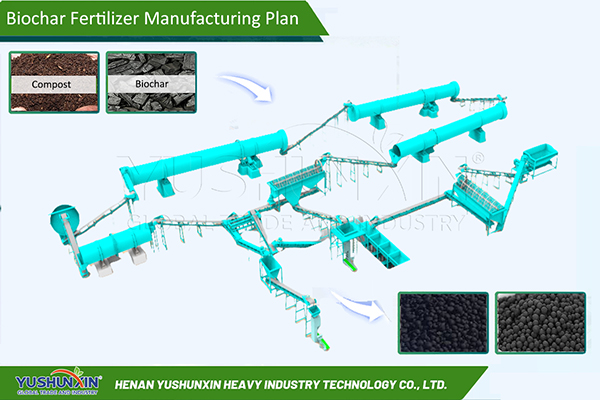Biochar is a carbon-rich product obtained from the thermal decomposition of organic material under limited oxygen conditions, a process known as pyrolysis. When use biochar as fertilizer, it can enhance soil fertility, improve water retention, and increase agricultural productivity. It also has the added benefit of sequestering carbon, thus playing a role in mitigating climate change. Here’s a detailed look at the biochar fertilizer production process:
Understanding Biochar
Biochar is created using biomass such as wood chips, crop residues, or manure. This biomass is converted into a stable form of carbon through pyrolysis. The resultant biochar can enhance soil properties and act as a slow-release fertilizer when enriched with nutrients.

The Biochar Fertilizer Production Process
- Feedstock Selection: The choice of feedstock is crucial as it influences the properties of the biochar. Woody materials, agricultural residues, or organic waste are common options. Each type has distinct characteristics that affect the biochar’s nutrient content and porosity.
- Pyrolysis: This is the core process where the biomass undergoes thermal decomposition in the absence of oxygen. The temperature typically ranges from 300°C to 700°C. Lower temperatures produce biochar with higher volatile matter, while higher temperatures result in more stable carbon structures.
- Cooling and Collection: After pyrolysis, the biochar must be cooled to prevent combustion upon exposure to air. It is then collected and stored for further processing.
- Making fertilizer with biochar: First, the biochar is often crushed and sieved to achieve a uniform particle size. Then mix biochar with compost and make biochar fertilizer granules. Click here to learn more.
Enhancing Biochar for Fertilizer Use
- Nutrient Enrichment: To enhance its effectiveness as a fertilizer, biochar can be enriched with nutrients. This is achieved by soaking the biochar in nutrient-rich solutions such as compost tea, manure slurry, or chemical fertilizers. This process increases its immediate fertility benefits by allowing it to act as a carrier for nutrients.
- Activation: Activation can further increase the biochar’s surface area and porosity, enhancing its ability to retain nutrients and water. This can be accomplished chemically (using acids or alkalis) or physically (using steam or heat).
Application and Benefits
Make fertilizer with biochar can improve soil structure, enhances nutrient retention, and boosts microbial activity. Its porous nature allows it to hold water and nutrients efficiently, reducing leaching and making them more available to plants. Moreover, biochar’s ability to sequester carbon makes it a valuable tool for combating climate change.
Environmental and Economic Impact
Producing biochar is not only beneficial for agriculture but also for waste management and carbon sequestration. By converting waste biomass into biochar, it reduces reliance on chemical fertilizers and contributes to a circular economy.
Conclusion
The biochar fertilizer production process involves converting organic waste into a valuable soil amendment through pyrolysis and nutrient enrichment. This not only enhances soil fertility and agricultural productivity but also provides significant environmental benefits by reducing greenhouse gas emissions and promoting sustainable land management practices. As research and technology in this field advance, biochar holds promising potential for sustainable agriculture and climate mitigation. If you want to learn more about biochar fertilizer making, you can visist https://www.fertilizerbusinessplan.com/how-to-make-biochar-fertilizer/